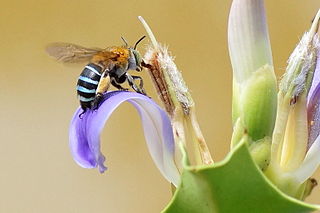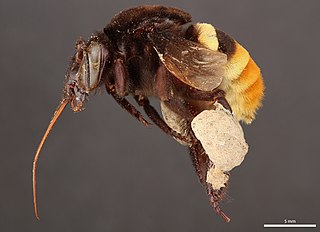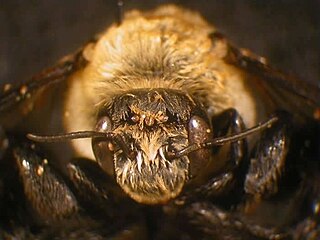Related Research Articles

Amegilla is a large genus of bees in the tribe Anthophorini. Several species have blue metallic bands on the abdomen, and are referred to as "blue-banded bees". The genus occurs all around the world but very few live above 45° North.

Eulaema is a genus of large-bodied euglossine bees that occur primarily in the Neotropics. They are robust brown or black bees, hairy or velvety, and often striped with yellow or orange, typically resembling bumblebees. They lack metallic coloration as occurs in the related genus Eufriesea.

Amegilla bombiformis, commonly known as the teddy bear bee or golden haired mortar bee, is an Australian native bee in the family Apidae.
Dasysphinx baroni is a moth of the subfamily Arctiinae. It was described by Rothschild in 1910. It is found in Ecuador.
Dasysphinx boettgeri is a moth of the subfamily Arctiinae. It was described by Rothschild in 1911. It is found in Peru.
Gymnelia buckleyi is a moth of the subfamily Arctiinae. It was described by Herbert Druce in 1883. It is found in Ecuador.
Dasysphinx flavibasis is a moth of the subfamily Arctiinae. It was described by Max Gaede in 1926. It is found in Peru.
Gymnelia herodes is a moth of the subfamily Arctiinae. It was described by Druce, 1883. It is found in Ecuador.
Dasysphinx mucescens is a moth of the subfamily Arctiinae. It was described by Felder in 1874. It is found in Colombia.
Dasysphinx ockendeni is a moth of the subfamily Arctiinae. It was described by Walter Rothschild in 1910. It is found in Peru. It is named after George Richard Ockenden, who collected the holotype.
Sarosa ozora is a moth of the subfamily Arctiinae. It was described by Herbert Druce in 1883. It is found in Colombia.
Dasysphinx pilosa is a moth of the subfamily Arctiinae. It was described by Rothschild in 1910. It is found in Peru.
Dasysphinx rubrilatera is a moth of the subfamily Arctiinae, found in Colombia. It was described by Max Gaede in 1926.
Dasysphinx semicincta is a moth of the subfamily Arctiinae. It was described by Paul Dognin in 1914. It is found in Colombia.
Dasysphinx tarsipuncta is a moth of the subfamily Arctiinae. It was described by William Schaus in 1905. It is found in Brazil.
Gymnelia torquatus is a moth of the subfamily Arctiinae. It was described by Herbert Druce in 1883. It is found in Brazil.
Dasysphinx volatilis is a moth of the subfamily Arctiinae. It was described by Schaus in 1910. It is found in Costa Rica.
The Euchromiina are a subtribe of tiger moths in the family Erebidae. It was described by Arthur Gardiner Butler in 1876. Many species in the subtribe are mimics of wasps.

Ptilothrix is a genus within the tribe Emphorini of the family Apidae. Bees of this genus can range from 7 to 15 millimeters. Ptilothrix species are solitary ground nesting bees. The genus has especially prominent hairs in the scopae of their hind legs, to help gather pollen to provision their nests. Ptilothrix specialize on certain families of plants for their pollen, including the families Malvaceae, Convolvulaceae, Onagraceae, Cactaceae, Pontederiaceae and Asteraceae. The genus is found in the new world, with species ranging from North to South America.

Ptilothrix bombiformis, known generally as the hibiscus bee or eastern digger bee, is a species of chimney bee in the family Apidae. It is found in Central America and North America.
References
- ↑ Beccaloni, G.; Scoble, M.; Kitching, I.; Simonsen, T.; Robinson, G.; Pitkin, B.; Hine, A.; Lyal, C., eds. (2003). "Dasysphinx bombiformis". The Global Lepidoptera Names Index . Natural History Museum . Retrieved May 1, 2018.
| This Euchromiina-related article is a stub. You can help Wikipedia by expanding it. |